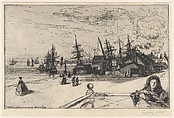Yacht Tavern, Erith
Sir Francis Seymour Haden British
Not on view
Seymour Haden was the unlikely combination of a surgeon and an etcher. Although he pursued a very successful medical career, he is mostly remembered for his etched work as well as for his writings on etching. He was one of a group of artists, including James McNeill Whistler (1834–1903) and Alphonse Legros (1837–1911), whose passionate interest in the medium led to the Etching Revival, a period that lasted well into the twentieth century. The extolling of etching for its inherent spontaneous qualities reached its pinnacle during this time. While the line of the etching needle, Haden wrote, was "free, expressive, full of vivacity," that of the burin was "cold, constrained, uninteresting," and "without identity". This print shows a pier in Erith, England, an area enjoyed for a short time as a riverside resort. As in Whistler’s "Black Lion's Wharf", Haden’s composition places an unsuspecting figure in the foreground, a choice perhaps inspired by period photography or Japanese woodblock prints. This print was done in the company of the Barbizon school painter Charles-François Daubigny whose name can be found inscribed on a storefront in the background at left.
"Trial Proofs:(b) The above-mentioned shading, and the signature 'Seymour Haden' on the rail of the wooden balcony, added."
[Source: Harrington, p. 54]
"State II (Db, 2 impressions; Hb). Additional etched work in water and in sky above the horizon at left, on the crossrails of the balcony, and ground, especially in front of small building with 'P.Burty de Paris' sign. Wear or burnishing of faint lines at the right of the girl's head. With the signature 'Seymour Haden'...
’This … [was] done on the same day in company with Monsieur Daubigny the eminent French landscape painter’." [Quote taken from Haden’s own handwritten annotations of Sir William Drake’s 'A Descriptive Catalogue of the Etched Work of Francis Seymour Haden'.][Source: Schneiderman, p. 225]
Due to rights restrictions, this image cannot be enlarged, viewed at full screen, or downloaded.


